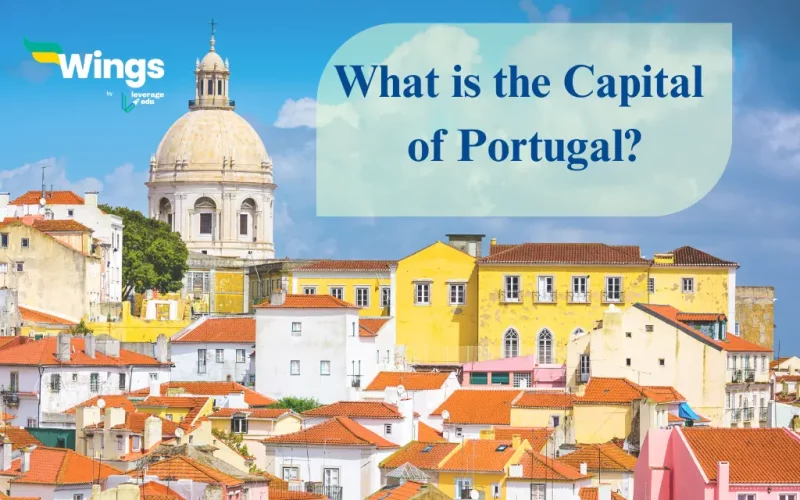The Capital of Portugal is Lisbon. Portugal, a country on the Iberian Peninsula in southwestern Europe with a rich history as a major European power, has a range of landscapes. The north is cold, rocky, and mountainous, while the south has a warm climate. The rugged Estrela Mountains, the highest point on mainland Portugal, lie between the Tagus and Mondego rivers. Additionally, the Capital of Portugal is the largest city in the country. In this article, we will discuss everything about the Capital of Portugal, Lisbon.
Table of Contents
Overview of Lisbon
We are sure you must have already heard of the play written by William Shakespeare with the character Julius Caesar. Well! This was a real character from Lisbon.
| Lisbon Overview | |
| Feature | Description |
| Capital of | Portugal |
| Population (City Limits) | 567,131 (2023) |
| Population (Metro Area) | 2,961,177 |
| Westernmost Capital (Mainland Europe) | Only capital city on the Atlantic Coast (among mainland European capitals) |
| Westernmost Point (Continental Europe) | Located within the Lisbon Metro Area (Portuguese Riviera) |
| Location | Western Iberian Peninsula, Northern Shore of Tagus River |
Brief History of Lisbon
Originally settled in 1628, Lisbon was originally known as Thompsonborough until 1802. It was not always, the Lisbon we know now.
- Early residents started manufacturing right away, forming a stock company in the year that is yet to be known.
- Land ownership shifted in 1798, hence prompting a division of Bowdoin Township.
- Thus, Lisbon became its own entity in 1799.
- The town’s location was inconvenient for meetings, hence the separation from Bowdoin.
- Today, Lisbon boasts a population of around 9,000 and offers scenic trails, shops, parks, and easy access to major highways.
Also Read: Top 10 Unbelievable Facts About the World
Demography of Lisbon
The population of Lisbon has been very different in different phases. Here are all the details of Lisbon’s demographics.
| Demography of Lisbon | ||
| Feature | Aspect | Details |
| Historical Population | 1300 1400 1500 1528-1590 1600 1700 | 35,000 60,000 70,000 Increased from 70,000 to 120,000 150,000 Almost 200,000 |
| City Composition | Population Area Density | 567,131 100.05 km² 5,668.5/km² |
| Metropolitan Area | Composition Population Estimates | Grande Lisboa (North Tagus) & Península de Setúbal (South Tagus) 2.7 – 2.96 million |
Geography of Lisbon
The exact location of Lisbon is the Mouth of the Tagus River, in the westernmost mainland European capital.
City Area: 100 km², with Monsanto Forest Park covering 10%.
Climate: Mediterranean
- Warm, rainy winters (avg. high 11-19°C in Jan)
- Hot, dry summers (avg. high 25-32°C in Aug)
- Mildest winter nights among major European cities (avg. low 8.3°C in Jan)
- Receives around 750mm of rain annually (most in Nov & Dec)
- Sunshine: 2806 hours/year (most in July, driest in July & Aug)
Also Read: What is the Capital City of Haryana?
Economy and Culture of Lisbon
Lisbon is an economically and culturally rich country. Here is everything you need to know about the economy and culture of Lisbon.
Economy of Lisbon
Lisbon is the economic powerhouse of Portugal and it is obvious since Lisbon is the capital city of Portugal.
- It generates a whopping 45% of the country’s GDP and boasts a GDP per capita well above the European Union average.
- Additionally, the region is experiencing rapid growth, with a strong tertiary sector.
- Major multinationals have set up headquarters in the Lisbon metropolitan area, particularly in Oeiras.
- Heavy industry is also a significant contributor to Lisbon’s economy, concentrated on the south bank of the Tagus River.
- Furthermore, there are key industries which include oil refining, textiles, shipbuilding, and fishing.
- The Port of Lisbon is one of the busiest in Europe, further solidifying Lisbon’s position as a major commercial hub.
Culture of Lisbon
Lisbon offers a vibrant cultural scene. The 1990s World Fair preparations significantly bolstered the city’s cultural offerings.
- New landmarks like the Belém Cultural Center emerged, showcasing visual and performing arts.
- This center joins a network of cultural institutions like libraries, research institutes, and museums.
- The city boasts a treasure trove of museums, catering to diverse artistic interests such as modern, ancient, sacred, decorative, and folk art.
- There are unique museums including the Azulejo Museum, showcasing Portugal’s famed painted tiles, and the National Museum of Coaches which has an impressive collection of historical carriages.
Also Read: What Is The Capital Of Maldives?
Facts about Lisbon
Here are the final part of this article. We will wrap the article with some of the amazing facts about the Capital of Portugal.
- Igreja de São Roque: One of the world’s most expensive chapels with an elaborate, gilded interior.
- Bridges: Holds the record for the longest bridge (Vasco da Gama) and longest suspension bridge (25th of April) in the European Union.
- Calçada Portuguesa: Traditional, patterned black and white cobblestone pavements found throughout Lisbon.
- Great Lisbon Earthquake: One of the deadliest earthquakes in history, nearly destroying the city in 1755.
- World Heritage Sites and Bookstores: Houses the Monastery of the Hieronymites and Belém Tower (UNESCO site) and boasts the oldest operating bookstore in the world (Livraria Bertrand) and the most bookstores per capita.
FAQs
Portugal is a relatively affordable place to travel to. This comparison is done with other European countries.
The average salary in Portugal is around €2,741 monthly. But, this number can change based on experience, skills, location, and gender.
The local languages are Spanish and Italian. However, the population of English-speaking people is larger in the country.
Related Blogs
This is everything about the Capital of Portugal. For more such content, visit our general knowledge page.
 One app for all your study abroad needs
One app for all your study abroad needs













